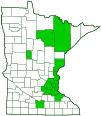bracket fungus
(Ganoderma lobatum)
Conservation • Description • Habitat • Ecology • Distribution • Taxonomy
|
|
||||||||||||||
Description |
Ganoderma lobatum is a common, wood decaying, bracket fungus. It occurs in North America, Central America, and South America, and there are scattered sightings in Europe, Asia, Africa, the Indian Subcontinent, and Australia. In the United States it occurs east of the Great Plains and in the Pacific Northwest. The genus Ganoderma is said to be perennial. However, Ganoderma lobatum produces a new fruiting body every year directly beneath the previous year’s growth. For this reason, some sources say that it is annual. Michael Kuo (MushroomExpert.com) says that it is “annual or perennial, lasting for 1–3 years.” Gary Emberger (Fungi Growing on Wood) says that it is annual, but it may appear perennial when the current year’s growth grows up into and fuses with the previous year’s decaying fruiting body. Ganoderma lobatum is found alone or in groups growing on dead hardwood logs and stumps and sometimes from the wounds of injured living trees. It sometimes grows on and gets its nutrients from dead wood (saprobic). It sometimes grows on living wood, causing a white to straw-colored rot in both the sapwood and the heartwood (parasitic). The mature cap is woody, semicircular to kidney-shaped, flattened, 4″ to 11¾″ (10 to 30 cm) wide, 3″ to 5½″ (8 to 14 cm) deep, and ⅜″ to 1″ (1 to 2.5 cm) thick. It is grayish red when fresh, becoming brown to grayish brown as it ages. The upper surface is dull, unvarnished, hairless, finely cracked, and wrinkled. It is often concentrically furrowed (zoned). It is hard but thin and crusty. It can be easily punctured with the thumb. The margin on actively growing brackets is white. The pore surface is whitish to grayish or pale brown when young. When bruised, it instantly discolors to yellowish or grayish brown, eventually turning brown. The entire pore surface turns brown as it ages. There are 4 to 6 tiny, circular pores per 1⁄32″ (1 mm). The tubes are 1⁄64″ to 1⁄16″ (0.5 to 1.5 mm) deep. The flesh is chestnut brown and cork-like. It is not edible. There is no stalk. The spore print is pale brown to dark brown. |
Similar Species |
Artist’s Conk (Ganoderma applanatum) produces a new layer of tubes on the same conk every year, and the entire conk remains alive. |
Habitat and Hosts |
Deciduous trees |
Ecology |
Season |
Year-round |
Distribution |
||
|
Sources |
|
| 10/20/2024 | ||
Occurrence |
||
Common |
||
Taxonomy |
|
Kingdom |
Fungi (Fungi) |
Subkingdom |
Dikarya |
Phylum |
Basidiomycota (Basidiomycete Fungi) |
Subphylum |
Agaricomycotina (Higher Basidiomycetes) |
Class |
Agaricomycetes (Mushrooms, Bracket Fungi, Puffballs, and Allies) |
Subclass |
incertae sedis (uncertain placement) |
Order |
Polyporales (shelf fungi) |
Family |
Polyporaceae/Ganodermataceae |
Genus |
Ganoderma (artist’s brackets, reishi, and allies) |
Subgenus |
Elfvingia (deprecated?) |
Genus |
|
Subordinate Taxa |
|
|
|
Synonyms |
|
Elfvingia lobata Fomes lobatus Polyporus lobatus Scindalma lobatum |
|
Common Names |
|
This species has no common name. The common name of the order Polyporaceae is bracket fungi, and it is applied here for convenience. |
|
Glossary
Parasitic
Obtaining nutrients from another living organism.
Saprobic
A term often used for saprotrophic fungi. Referring to fungi that obtain their nutrients from decayed organic matter.
Visitor Photos |
||
Share your photo of this fungus. |
||
This button not working for you? |
||
Amy Stifter |
 |
MinnesotaSeasons.com Photos |
||
|
||
|
||

Slideshows |
|

Visitor Videos |
||
Share your video of this fungus. |
||
This button not working for you? |
||
|
Other Videos |
||
Ganoderma lobatum |
About
Oct 22, 2023 Ganoderma lobatum merupakan jamur patogen tanaman. Jamur Ganoderma dapat menyebabkan busuk akar dan batang pada tumbuhan tahunan. Google Translate: Ganoderma lobatum is a plant pathogenic fungus. Ganoderma fungi can cause root and stem rot in perennial plants. |

|
Created: 10/20/2024 Last Updated: © MinnesotaSeasons.com. All rights reserved. |


